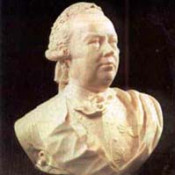
Anniversary of Russian commander and statesman, count Peter Alexandrovich Rumyantsev-Zadunaisky
On January 4 (15), 1725 was born a Russian commander and statesman, count Peter Alexandrovich Rumyantsev-Zadunaisky. His father, general en chef A.I. Rumyantsev was an associate of Peter I, a member of the most important battles of the North war and the Russia-Persian war. His mother was a granddaughter of A.S. Matveev, a tutor of Peter the Great’s mother, Natalia Naryshkina the tsarina. Peter Alexandrovich’s godmother was Catherine I.
At the age of six Rumyantsev was sent to the Life Guard of Preobrazhensky regiment as a private soldier. The future commander was well educated at home and in 1739 was appointed for a diplomatic service and became a Russian ambassador in Berlin.
The first place of military service for Peter Alexandrovich was Finland. There he participated in the Russian-Sweden war of 1741-1743. In 1743 it was Rumyantsev who brought to Petersburg the news of Abo treaty conclusion. For this deed Elisabeth the empress immediately promoted him from the rank of captain to the rank of colonel and appointed the commander of Voronezh infantry regiment.
During the Seven years war of 1756-1762 Rumyantsev, already in the rank of major-general, successfully commanded a brigade near Gross-Jägersdorf (1757) and a division in the battle of Kunersdorf (1759). In 1761 being the commander of a corps he directed the siege of Kolberg (Kolobrzeg) fortress. During the siege for the first in the history of the Russian arms Rumyantsev-Zadunaisky used the elements of a tactic system “close column – extended order”.
For his military service Peter III awarded Rumyantsev with the orders of St. Anna and St. Andrew and conferred him the rank of general en chef. In the end of 1764 Catherine the Great appointed Rumyantsev the governor-general of Little Russia and the president of Little Russia board. She furnished him with a detailed instruction according to which he should assist to a closer administrative unification of Little Russia and Russia. It implied the liquidation of Ukrainian autonomy and transformation of Little Russia into a Russian Empire province. As a result of Rumyantsev activity the traditional administrative division of Ukraine disappeared and in its territory spread the serfdom.
In the beginning of the Russo-Turkish war of 1768–1774 Rumyantsev commanded the 2nd Army. Having demonstrated greater efficiency than A.M. Golitsyn who was at the head of the 1st Army, by the beginning of the second campaign (1787–1791) Rumyantsev took his place. In the spring of 1770 the First army passed to the offensive and won a series of brilliant victories near Ryabaya Mogila, then near Larga and Kagul river. When in July of 1774 Rumyantsev concluded the treaty advantageous for Russia, Catherin II wrote him that it was “the outstanding service rendered to us and the Fatherland”. A year later during the official celebration of the victory of Turks in Petersburg Rumyantsev was given a field marshal’s baton, an honorary title of count Zadunaisky, the orders of St. Andrew covered with diamonds, a laurels and an olive branch.
P. A. Rumyantsev-Zadunaisky made a great contribution to the Russian military art development of the second half of the 18th century. He perfectly organized the regular army training, applied new, more progressive forms of battling. Already during the Seven years war Peter Alexandrovich initiated the introduction of new battle orders, for the first time he put into practice battalion columns for maneuvering on the battlefield, created light battalions (future chasseurs) that were used in the extended order. This new tactic and strategy of attack was later used by the Russian commanders A.V. Suvorov and M. I. Kutuzov. During the Russian-Turkish war of 1768-1774 Rumyantsev applied the principle of a decisive battle as the main way of winning. His generalship was characterized by the use of the mobile squares, combination of front and flank strikes, creation and use of tactic reserves, organization of different arms of the service’ cooperation. Also the field marshal general paid a great attention to the material security of soldiers and their education. Rumyantsev set forth his ideas in his military theoretical works: “Instructions” (1761), “Service rite” (1770) and “Thoughts” (1777) that were used during the regulations’ drawing up and the Russian army reorganization in the second half of the 18th century.
Peter Alexandrovich Rumyantsev-Zadunaisky died on December 8 (19), 1796 in his estate Tashan’ near Kiev and was buried in Kiev Pechersk Lavra near the left choir of the conciliar church of the Assumption of Virgin Mary.
In 1799 on The Field of Mars in St.-Petersburg was erected the monument to Rumyantsev in a form of a small black stele with the inscription “To Rumyantsev victories” on it. At the present the monument is placed in Rumyantsev public garden on the University embankment.
Lit.: Бантыш-Каменский Д. Н. 26-й генерал-фельдмаршал граф Пётр Александрович Румянцев-Задунайский // Биографии российских генералиссимусов и генерал-фельдмаршалов. Ч. 2. М., 1991; То же [Электронный ресурс]. URL: http://militera.lib.ru/bio/bantysh-kamensky/29.html; Меерович Г. И. Румянцев в Петербурге. Л., 1987; Пронин А. Гордость Отечества: русский Трюненн, русский Велисарий // Братишка. 2005. № 10; Фельдмаршал Румянцев. Документы. Письма. Воспоминания. М., 2001.
Based on the Presidential Library’s materials:

